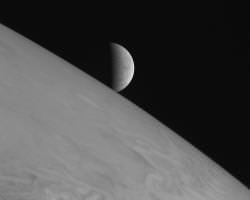Although its primary target will be Pluto, NASA’s New Horizons spacecraft is taking the time to do a little science along the way. During its recent Jupiter flyby, the spacecraft was able to test out its scientific instruments as a dress rehearsal for its final Pluto encounter. NASA held a big press conference this week, and released dozens of new images and scientific findings gathered by New Horizons.
New Horizons made its closest approach to Jupiter on February 28, 2007 when it came within 2.3 million km (1.4 million miles) of the giant planet. As part of this flyby, it captured the closest ever view of Jupiter’s “Little Red Spot”, detailed images of its faint rings, and events on its moons. It made a total of 700 observations, and it’s now transmitting that data back to Earth – 70% of the 34 gigabits of data have been returned so far.
The spacecraft made many discoveries. Here are a few examples. It’s view of “Little Red” shows how these kinds of vast storms evolve in Jupiter’s high atmosphere. It showed how the planet’s rings change quickly, over the course of weeks and months and revealed the effect of a recent impact. It made several observations of Jupiter’s moon Io, with its volcanic plumes scattering lava across its surface.
New Horizons is the fastest spacecraft ever launched. This Jupiter flyby gave it an additional speed boost, and helped put it on target to reach Pluto in 2015.
All the images presented by NASA are available here.
Original Source: NASA News Release


When I went to view the pictures, the link appeared broken. It said that it didn’t work.